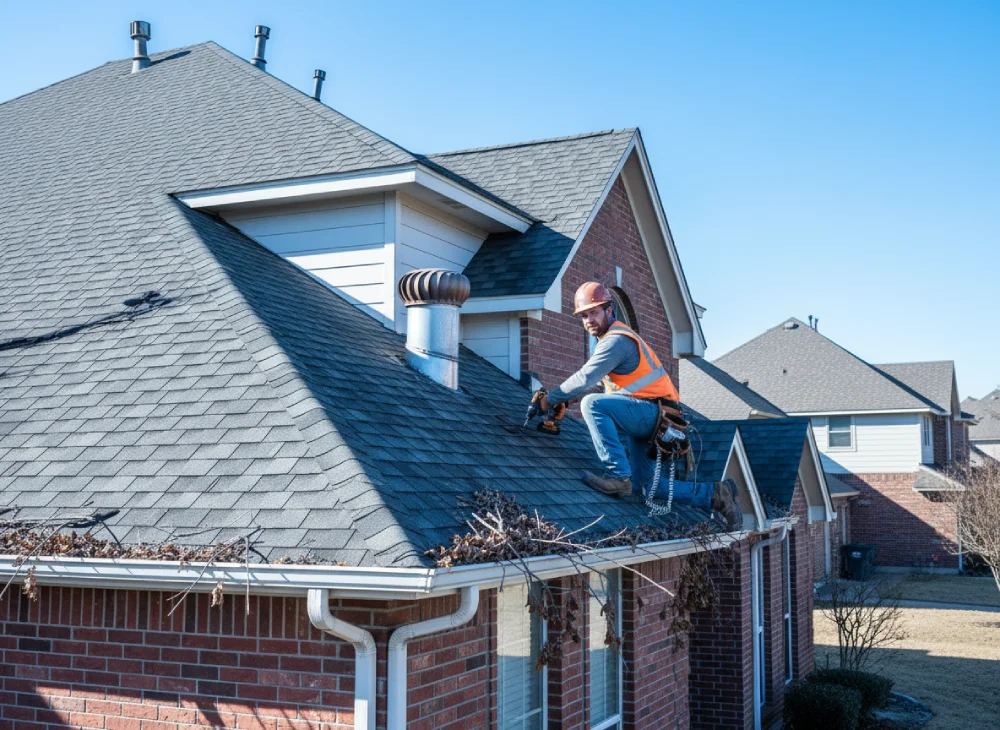
Roofer mistakes in North Texas include hiring unlicensed contractors, accepting deductible waivers, delaying inspections, and ignoring proper installation temperatures—errors that can cost homeowners thousands in repairs and void warranties.
After severe weather hits Denton County and surrounding areas, the rush to repair storm damage often leads property owners down costly paths. We've seen it time and again: smart homeowners making preventable mistakes simply because they don't know what to look for. Understanding these common pitfalls protects your home, your investment, and your peace of mind.
The pressure to act fast after storm damage creates perfect conditions for making rushed decisions. We see homeowners skip essential due diligence steps, leaving them vulnerable to contractors who shouldn't be touching their roofs.
Hiring unlicensed contractors exposes you to substantial liability when injuries occur or work fails. Storm-chasers offering unrealistically low bids often compromise workmanship, void warranties, and create problems that cost more to fix than the original repair.
Many property owners focus solely on the lowest bid without recognizing that quality roofers maintain consistent pricing. That pricing reflects proper materials, trained crews, and installation techniques that protect your investment.
Without this verification, you're essentially trusting a stranger with one of your home's most critical systems.
Payment mistakes often prove more devastating than poor contractor selection. We've helped homeowners recover from situations where they transferred funds before work began, only to watch contractors disappear.
Storm-chaser contractors exploit disaster situations by requesting upfront payments or demanding your full insurance check. They target vulnerable property owners who feel pressured after storm damage, then vanish without completing repairs or purchasing materials.
Red flags include:
Small cracks in shingles and barely visible water stains rarely trigger urgency. Yet these seemingly insignificant issues represent the early stages of costly structural damage.
Water infiltration escalates from surface issues to structural compromise within months. Insurance complications arise when damage progression obscures the original cause, potentially affecting your claim eligibility.
Professional inspections detect problems before visible symptoms appear. We find issues during routine checks that would otherwise go unnoticed for months or years—saving homeowners thousands in emergency repairs.
We understand the appeal of saving money with DIY repairs. But climbing onto your roof with a caulking gun and optimism often transforms minor repair needs into major structural liabilities.
Safety risks multiply quickly:
Technical failures compound:
| DIY Approach | Why It Fails | Professional Solution |
| Hardware store sealants | Not rated for roofing exposure | Butyl tape and urethane rated for metal roofing |
| Over-tightening screws | Creates leak pathways | Proper torque specifications |
| Painting over rust | Doesn't stop corrosion | Inhibitor treatment and appropriate priming |
Amateur attempts void manufacturer warranties and trigger insurance claim denials. Improper flashing installation and inadequate structural assessments convert affordable fixes into expensive system replacements.
We've restored dozens of roofs where well-intentioned DIY work created secondary damage pathways. The original repair would have been straightforward—the DIY aftermath required complete section replacements.
Regular inspections stand between North Texas homeowners and premature roof failure. Yet most property owners wait until visible leaks force emergency interventions.
Bi-annual inspections during spring and fall, combined with consistent gutter cleaning, can double roof lifespan from 15 to 30 years. This preventive approach costs only 10-20% of reactive repairs while providing substantially better outcomes.
Critical maintenance priorities:
Dallas's humid climate accelerates algae growth and organic debris accumulation. Scheduled maintenance isn't optional—it's essential for protecting your roofing investment against Texas-specific environmental threats.
During routine checks, we commonly find:
These issues cost pennies to address early, dollars to fix later.
Professional installation determines whether your North Texas roof survives 25 years or fails within a decade. Installation quality oversights represent the most preventable category of roofing failures.
Homeowners frequently overlook critical warning signs during installation. Improper nailing patterns compromise shingle adhesion during windstorms. Inadequate flashing around chimneys creates leak pathways from day one.
Material durability becomes irrelevant when contractors use incorrect fastener placement or install shingles below recommended temperatures, preventing proper bonding.
Red flags during installation:
Many homeowners unknowingly hire unlicensed contractors whose substandard installation techniques void manufacturer warranties and violate Texas Department of Insurance guidelines.
Protect your investment:
Verifying proper installation methods protects both your immediate investment and long-term roof performance throughout demanding North Texas weather conditions.
North Texas weather patterns create unique challenges that homeowners frequently overlook when scheduling roof work. Timing decisions directly impact installation quality and material performance.
When severe weather strikes Denton County, many homeowners underestimate the urgency of scheduling a roof inspection. The region experiences 4-6 significant hail events annually, with stones ranging from pea to golf ball size causing hidden structural compromise.
Why delays matter:
Recent data shows 76% of inspected commercial roofs contained undetected storm damage. This demonstrates how easily homeowners overlook critical issues requiring immediate attention.
Installation temperatures directly impact material performance and longevity. North Texas experiences extreme heat exceeding 100°F during summer months, creating conditions where asphalt shingles cannot properly seal.
Optimal installation conditions:
| Season | Temperature Range | Installation Suitability |
| Summer | Often >100°F | Poor – Premature sealant drying |
| Fall | 40-85°F | Excellent – Optimal adhesion |
| Winter | Often <40°F | Poor – Sealing strips don't activate |
| Spring | 40-85°F | Excellent – Ideal bonding conditions |
These materials require temperatures between 40-85°F for optimal adhesion and self-sealing capability. Installing during excessive heat causes premature sealant drying before proper bonding occurs. Winter installations below 40°F prevent activation of sealing strips entirely.
Thermal expansion becomes problematic when materials expand during hot installations, then contract significantly during cooler months, leading to warping and gaps. Professional contractors recognize these temperature constraints and schedule accordingly.
Smart decisions about contractor selection, timely repairs, and proper maintenance prevent costly damage down the road. These seven mistakes cost North Texas homeowners thousands each year—money that could stay in your pocket with the right approach.
Your action plan:
We've been serving North Texas homeowners since 2006, helping our neighbors avoid these costly mistakes. Taking these precautions now saves money, extends roof lifespan, and maintains home value for years to come.
Ready to protect your home? Contact TriStar Built for a professional roof assessment. We'll help you understand your roof's current condition and create a maintenance plan that works for your property and budget.
Schedule professional inspections of your roofing system twice annually—once in spring and once in fall. These seasonal checks help homeowners avoid common roofing mistakes and catch small leaks or missing shingles before they lead to costly repairs. Proactive maintenance can double your roof’s lifespan from 15 to 30 years. After major storms, especially hail or high winds, schedule an additional inspection within two weeks to document any roof damage before it escalates.
Yes. Waiving insurance deductibles is illegal in Texas. A contractor offering to do so is likely engaging in fraudulent practices, one of the common mistakes homeowners make when choosing a roof repair service. This arrangement often involves fake documentation and can cause your insurance company to deny your claim—resulting in unexpected and costly repairs.
For asphalt shingles, proper installation requires temperatures between 40–85°F. Above 100°F, sealants on your roofing system can dry out prematurely before bonding occurs; below 40°F, sealing strips may not activate properly. Early spring and fall are optimal times for roof replacement in North Texas, offering favorable conditions to maximize both durability and energy efficiency.
Book your inspection within 1–2 weeks after a significant storm. Studies show 76% of roofs suffer undetected storm damage—often missing shingles, punctures, or displacement. Delays can allow these issues to worsen, leading to roof replacement sooner than necessary. Proactive inspections help prevent small leaks from turning into costly repairs.
Choose a contractor with valid insurance, manufacturer certifications for your specific materials, and solid Better Business Bureau ratings. Verifiable references are essential to avoid mistakes homeowners often make when hiring roof repair professionals. In Texas, check the Texas Department of Insurance to confirm their standing and review any complaint history before moving forward.

Whether you’re remodeling a home, expanding a business, or starting from the ground up, TriStar Built is here to guide you every step of the way. With a focus on craftsmanship, communication, and results that last, we make the construction process clear, smooth, and worth every investment.

LOCATION: 2126 James Street, Denton, TX 76205
PHONE: (940) 381-2222
© 2025 TRISTAR BUILT - ALL RIGHTS RESERVED | WEB DESIGN & SEO BY: Authority Solutions®